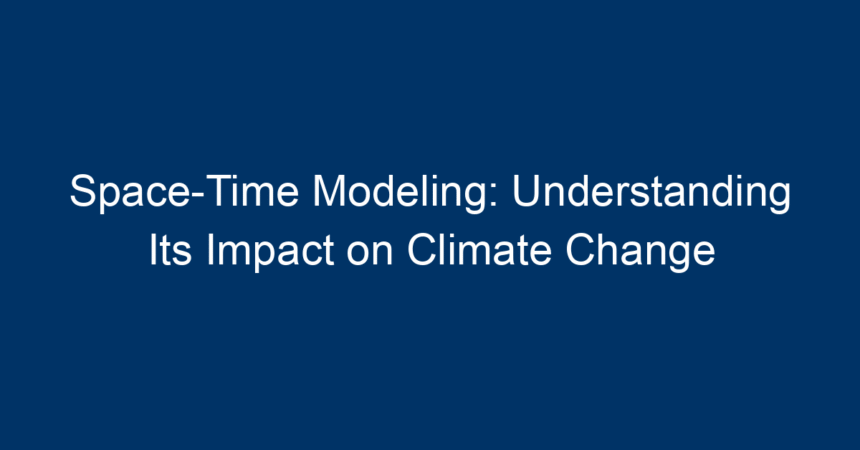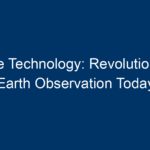Climate change is one of the biggest challenges facing humanity today, affecting ecosystems, weather patterns, and economies worldwide. To tackle this multifaceted issue, scientists and researchers employ various methods to analyze and predict environmental changes. Among these methods, space-time modeling stands out as a powerful tool. This article delves into space-time modeling, its applications in climate change studies, and its potential to provide actionable insights for policymakers and society.
What is Space-Time Modeling?
Space-time modeling refers to statistical and computational techniques that analyze data across both spatial and temporal dimensions. This approach provides insights by considering how variables interact over time and space. In climate science, for example, space-time modeling can evaluate how temperature changes in one region may influence climate phenomena in another.
The Importance of Space-Time Modeling in Climate Studies
Climate change is inherently dynamic, affecting different regions in diverse ways. Traditional models, which might focus on just one aspect—like temperature changes or precipitation patterns—risk overlooking vital interactions. Space-time modeling addresses these gaps, enabling researchers to:
- Capture Complex Interactions: Understand how changes in one aspect of the climate can trigger cascading effects elsewhere.
- Predict Future Scenarios: Generate robust predictions by incorporating various environmental factors.
- Identify Regional Variability: Recognize that climate change does not affect all regions equally, which is critical for tailoring local responses.
Applications of Space-Time Modeling in Climate Change
Space-time modeling has a wide array of applications in climate science. Below are some notable examples:
1. Monitoring Temperature Trends
One of the most straightforward applications of space-time modeling lies in analyzing long-term temperature data. Researchers can plot temperature changes over time for various geographical regions to identify trends. This monitoring can highlight regions that are warming at an accelerated rate, providing critical data for climate adaptation strategies.
2. Analyzing Precipitation Patterns
Understanding changes in precipitation is crucial for agriculture, water resource management, and flood prediction. Space-time modeling allows for the analysis of rainfall distribution over time. By examining how rainfall varies seasonally and geographically, scientists can forecast water shortages or flooding events, enabling better preparedness.
3. Assessing Climate-Related Risks
Space-time modeling also facilitates risk assessments related to climate change, such as extreme weather events. With this method, researchers can evaluate the likelihood of events like hurricanes or droughts occurring under different temperature scenarios, allowing communities to plan accordingly.
4. Ecosystem Impact Analysis
The impact of climate change extends beyond weather patterns to affect biodiversity and ecosystems. Space-time modeling can examine the interactions between climate variables and species distribution. This approach helps identify vulnerable species and ecosystems, guiding conservation efforts more effectively.
The Techniques Behind Space-Time Modeling
Understanding space-time modeling’s methodologies is critical for grasping its significance in climate studies. The following techniques are often employed:
1. Geostatistics
Geostatistics involves statistical models that consider spatial relationships. It helps in understanding how environmental variables are distributed across geographical areas. This technique can pinpoint areas vulnerable to climate impacts, facilitating targeted intervention efforts.
2. Machine Learning
Machine learning techniques are increasingly being adopted in space-time modeling. By training algorithms on large datasets of climate variables, researchers can develop predictive models that enhance forecasting accuracy. These models can adapt over time as new data becomes available, making them particularly useful for long-term climate projections.
3. Simulation Models
Simulation models allow researchers to create hypothetical scenarios based on current data. By adjusting variables, scientists can simulate how different climate policies might affect future temperatures or precipitation patterns. This capability is crucial for testing the effectiveness of various climate strategies before implementation.
Challenges in Space-Time Modeling
Despite its advantages, space-time modeling faces challenges:
1. Data Quality and Availability
Accurate space-time modeling relies on high-quality data. Unfortunately, gaps in climate data can hamper model accuracy. This issue is particularly severe in less developed regions, where climate monitoring systems may be inadequate.
2. Complexity of Climate Systems
The climate system is inherently complex and influenced by numerous variables. Modeling these interactions requires sophisticated algorithms and can lead to uncertainties in predictions.
3. Computational Requirements
Space-time modeling often involves processing vast datasets, demanding significant computational power. This requirement can limit access for smaller research organizations.
Actionable Insights for Policymakers
As our understanding of space-time modeling evolves, actionable insights can emerge for local and global policymakers. Here are several key recommendations:
1. Invest in Data Collection and Monitoring
Improving data collection systems can significantly enhance space-time modeling efforts. Investment in climate monitoring technology and infrastructure will ensure that research remains accurate and relevant.
2. Foster Interdisciplinary Collaboration
Collaboration among climate scientists, statisticians, and policymakers is vital for effective space-time modeling. By combining expertise, these teams can produce models that are not only scientifically robust but also practically applicable.
3. Prioritize Local Adaptation Strategies
Understanding local climate dynamics through space-time modeling can inform tailored adaptation strategies. Policymakers should leverage model outputs to develop targeted responses that address specific regional needs, enhancing community resilience.
4. Promote Public Awareness and Engagement
Raising public awareness about the implications of climate modeling can encourage community involvement in climate action. Engaging the public can facilitate local adaptation efforts and support for necessary policy changes.
Conclusion
Space-time modeling is an essential component of contemporary climate science. Its ability to analyze complex interactions across different dimensions enables more accurate predictions and informed decision-making. As climate change continues to pose significant challenges, understanding and leveraging space-time modeling can be a game-changer for effective climate mitigation and adaptation strategies. By investing in data, collaboration, local strategies, and public engagement, we can enhance our response to climate change, making strides toward a more sustainable future.
Incorporating space-time modeling into climate change discussions is crucial for developing solutions that are responsive, equitable, and scientifically sound. As we navigate the complexities of our changing climate, leveraging the insights from this powerful modeling technique will be imperative for the global community.




